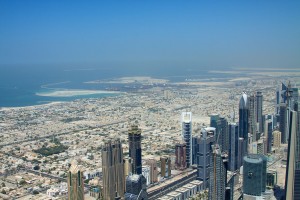23 February 2016
Dubai construction alters local climate
Posted by Nanci Bompey
By Nanci Bompey

Dubai coast and island construction in 2010. A new study shows that Dubai construction has altered the local climate.
Credit: McKay Savage/Wikimedia Commons
The climate of Dubai is quickly growing less hospitable, according to authors of a new study.
Temperatures in newly urbanized areas of Dubai have increased by up to 2 degrees Celsius (3.6 degrees Fahrenheit) since 2001, and massive construction and building of parks over the last 14 years also caused increases in humidity and declines in wind intensity, according to new research. All of this could make the city a much less comfortable place to be outdoors, according to the study’s authors.
Dubai – the largest city in the United Arab Emirates — witnessed dramatic construction on land and sea over the past two decades. In addition to increased urbanization within the city, several artificial islands have been constructed in the water off the city’s coast.
Construction of buildings, road and other facilities in Dubai caused the albedo, or the amount of solar radiation reflected back to space, to decline significantly from 2001 to 2014, the new study finds. Unlike the highly reflective near-white desert, the darker buildings and roads absorb more solar energy, according to the study’s authors. With more solar radiation being absorbed, and an increase in heat-intensive activities like fuel burning and car exhaust that comes with increased urbanization, temperatures in Dubai increased by up to 2 degrees Celsius (3.6 degrees Fahrenheit) over the 14 years studied.
Irrigation of the desert landscape drove up humidity by up to 4 percent in Dubai and the surrounding region, while construction of buildings and planting of trees caused wind intensity in some areas of the region to decline by about 0.7 kilometers per hour (0.4 miles per hour), according to the new study.
These changes act to increase the discomfort index, or the amount of heat stress on an individual that takes into account temperature and humidity, according to the study’s authors. A drop in wind intensity at locations where it was observed also increased the heat stress, they said.
“All three are acting in a direction which is not favorable for living in the outside climate,” said Pinhas Alpert, an atmospheric scientist at Tel Aviv University in Israel, and a co-author of the new study accepted for publication in Earth’s Future, a journal of the American Geophysical Union.
These changes could also be affecting the local ecosystem, he said. “People are not aware that when they do construction activities, they actually change the local climate,” Alpert said.
Previous studies of the effects of construction in Dubai focused on the impacts either on the sea or the land, while the new study examines the atmospheric effects over both land and sea. In addition, the new study uses satellite data as well as data from meteorological stations to assess the impacts over a large area that includes Dubai, Abu Dhabi and other parts of the region.
In addition to the effects seen on land, the study also examined the effects of the construction of artificial islands in the water off the coast of Dubai. Unlike open water, where much of the solar radiation is absorbed, the artificial islands caused albedo to increase, or more solar radiation to be reflected back to space. This caused temperatures to decline slightly, by less than 0.5 degrees Celsius (0.9 degrees Fahrenheit), from 2001 to 2014.
Alpert said these changes could affect what is happening in the Persian Gulf and the ecosystem there, just as the changes on land could be affecting the plants and animals native to the desert.
Alpert said Dubai – where massive construction has occurred over a short time-period – serves as a laboratory for scientists to study an extreme case of human activity and its impact on the climate. Studying a city like Dubai can help scientists understand what happens over megacities globally, he said.
“Extreme cases are always interesting to study because they provide you with the most extreme way that humankind can change its environment,” Alpert said.
Emily Elhacham, an undergraduate student at Tel Aviv University and lead author of the new study, said the research could help scientists figure out what might happen as other parts of the world undergo rapid urbanization.
“I think it is a good case study for a trend that we might see more of in the future,” she said.
— Nanci Bompey is the public information manager at AGU.










 GeoSpace is a blog on Earth and space science, managed by AGU’s Public Information staff. The blog features posts by AGU writers and guest contributors on all sorts of relevant science topics, but with a focus on new research and geo and space sciences-related stories that are currently in the news.
GeoSpace is a blog on Earth and space science, managed by AGU’s Public Information staff. The blog features posts by AGU writers and guest contributors on all sorts of relevant science topics, but with a focus on new research and geo and space sciences-related stories that are currently in the news.